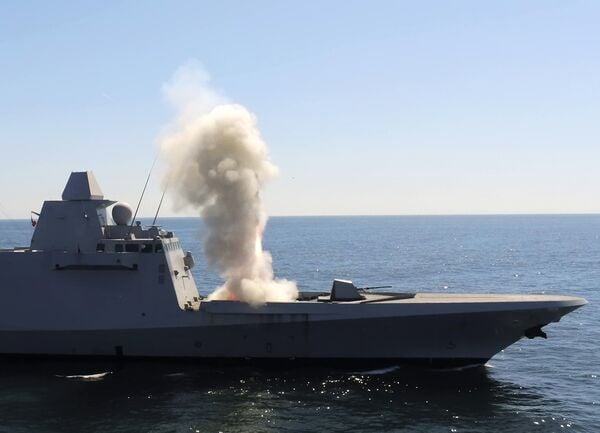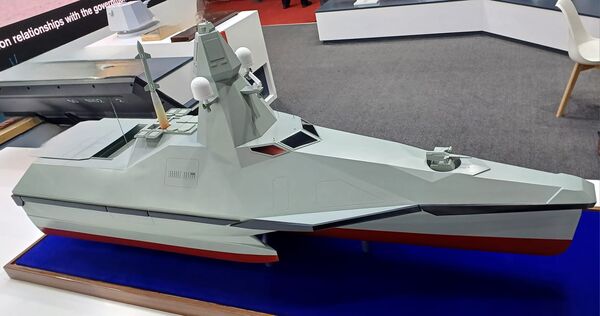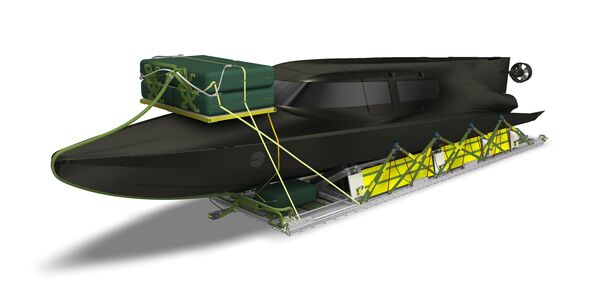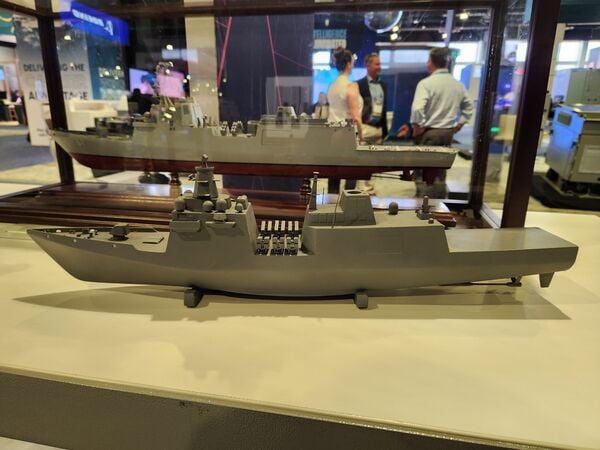- About
- Intara
- Capabilities
- Advisory
- Resources
- News
- Store
French Navy conducts first synchronised firing of MdCN naval cruise missile
23 April 2024
by Kate Tringham


MdCN is launched from the FREMM frigate Aquitaine on 18 April. (French Navy)
The French Navy has successfully conducted its first simultaneous test launch of the Missile de Croisière Navale (MdCN)naval cruise missile from a frigate and a submarine.
The test-firing was carried out by the service's lead multimission (FREMM) frigate Aquitaine, positioned off the coast of Brittany, and one of its Suffren (Barracuda)-class nuclear-powered attack submarines (SSNs), located off the coast of Biscarrosse, on 18 April, the Ministry of Armed Forces of France confirmed the same day.
During the test the two vessels launched a co-ordinated strike against a ground target located at the DGA's Biscarrosse missile test centre at Landes in southwestern France – with both missiles engaging their target “in perfect synchronisation”, the Ministry of Armed Forces of France said.
In a statement issued the same day the French Navy said the test was carried out in operational conditions to strengthen the operational know-how and combat skills of the service.
DSA 2024: Chinese company Poly Technologies showcases missile-capable USV
08 May 2024
by Vinod Kumar CV


The Poly Technologies A2000 attack USV on display at DSA 2024. (Janes/Vinod Kumar CV)
Chinese defence company Poly Technologies showcased the A2000, a new next-generation combat unmanned surface vessel (USV), at the Defence Services Asia (DSA) 2024 exhibition held in Kuala Lumpur from 6 to 9 May.
The A2000 attack USV has a length of 45 m, a displacement of 280 tonnes, and a top speed of 35 kt. It features twin diesel engines and two controllable pitch propellers.
It is equipped with an active electronically scanned array (AESA) radar for surveillance and is integrated with an eight-cell vertical launching system for launching surface-to-air missiles, and 24-cell launchers at both sides for rockets. However, it is not fitted with anti-ship missile launchers.
The USV can co-ordinate with smaller vessels for a swarm attack, provide air defence, and extend its reach via satellite connectivity. Its trimaran hull design minimises radar detection. It also supports vertical take-off and landing (VTOL) unmanned aircraft system (UAS) operations for enhanced surveillance, positioning it as a versatile asset for peacetime and conflict scenarios.
SubSea Craft teams with Capewell to explore Victa DDU air deployment opportunities
07 May 2024
by Kate Tringham


Victa integrated with Capewell's UMCADS. (SubSea Craft)
UK-based SubSea Craft has joined forces with Capewell Europe to explore the air deployability of its Victa diver delivery unit (DDU) prototype when integrated onboard the latter's newly developed Universal Maritime Craft Aerial Delivery System (UMCADS).
Speaking to Janes on 1 May, Lee Ebsworth, SubSea Craft's chief commercial officer, said the partnership has mutual opportunities as the two companies work together to increase the evidence bank for Victa as a deployable air asset as well as to demonstrate the flexibility of Capewell's UMCADS.
“While we continuously push the technological edge in our platforms to give operators the advantage, their effectiveness hinges on successful deployment into the area of operations,” he said. “We've prioritised ensuring Victa's flexibility in deployment, and conducting feasibility studies with Capewell enables us to expand the available options against the most demanding scenarios.” What is particularly valuable about UMCADS is its configurable nature, which not only supports Victa but also complements other concepts currently in development, he added.
Based around a monohull design constructed of carbon fibre and Diab core, SubSea Craft's
Gibbs & Cox takes aim at light frigate market with International-class design
07 May 2024
by Jeremiah Cushman


A model of the Gibbs & Cox International-class light frigate displayed at the Navy League Sea-Air-Space exposition in April 2024. (Janes/Jeremiah Cushman)
Gibbs & Cox, a wholly owned subsidiary of Leidos, has developed a platform to meet global demand for smaller frigates, William Cowardin Jr, vice-president for global ship design, Gibbs & Cox, told Janes in April during the Navy League Sea-Air-Space 2024 global maritime exposition in National Harbor, Maryland. What the company calls the International class began as an internal research and development effort to develop a next-generation hull and test it to determine how big or small it could be and various mission packages that could be integrated, he said.
The design is simpler to construct so that it can be produced by smaller shipyards or yards that have not previously built warships. It employs mature technologies, such as the GE Aerospace LM2500 gas turbine with a basic combined diesel-electric and gas (CODLOG) propulsion architecture, Cowardin Jr said. Gibbs & Cox brings significant experience in working with shipyards, including being able to tailor production packages to meet a yard's specific needs.
The French Navy has successfully conducted its first simultaneous test launch of the Missile de Croi...
Latest Podcasts
Using OSINT to support law enforcement
Ritu Gill, Intelligence Analyst, joins Harry and Sean to discuss the practical use of OSINT to support law enforcement. Ritu discusses it’s use in supporting risk assessments and classified or closed sources of intelligence. She also discusses t...
Listen nowJanes Case Studies
Using Janes Intara to build a common intelligence picture: Russian build up on the Ukrainian border
View Case StudyNews Categories
 Weapons Details
Weapons Details